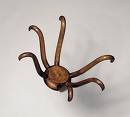Since my mother was diagnosed with cancer I have not have much time or energy to go out and see many art exhibitions. In addition to that, there hasn’t been much time for even working in the studio. Other than the small drawings I have done I have been sort of out of the art loop.
In saying that, Monday I was able to make it over to the Mildred Lane Kemper Art Museum on the campus of Washington University. I also what to state that I like going there to see contemporary art than I like going to the Contemporary Art Museum St. Louis. I think the exhibitions at the Kemper are more varied and I like that the museum is free and being in the situation I am in, free is great. I honestly have not been too interested in the recent exhibitions at CAMSTL.
The exhibitions I saw were Chance Aesthetics and Metabolic City. I will separate the two into separate posts. I was interested in Chance Aesthetics because in my own art I have used elements of chance to develop my work. I tend to use it as a starting point such as dumping ink or paint, using drip patterns and allowing “mistakes” to happen and worked with the unexpected things that come up when making art.
Historically, art has been a skill in which an artist demands exceptional control to achieve a great work. This means works were planned endeavors obsessive perfection. In the 20th century some artists decided to work in opposition to this. The exhibition starts with the Surrealists and Dada, which makes sense to me. What I think is so great about using chance as a basis for a work is that it becomes playful and fun instead of being an intellectual and dry assignment that a lot of art has become.
Some of the works are sloppy and dirty but some are totally obsessive, clean and systematic. The latter still retain an element of surprise and engagement.
Some notable artists and works. I like Ellsworth Kelly’s gridded, cut-up and reassembled drawings.

Ellsworth Kelly
There is Mimmo Rotella’s decollages of advertisements that you might see on the streets where posters are layered and ripped apart. Sort of like a defaced pop art.

Mimmo Rotella
Similar to Rotella’s is Jacques Villegle’s work. Something is very subversive and punk about these works. I like that.

Jacques Villegle
I did love the simplicity of Duchamp’s readymade, “hatrack”, that was hanging from the ceiling. I think most people would see the spider-like look of this work and I think most would enjoy this one cause of its playfullness and it is non-confrontational.

Marcel Duchamp
I enjoyed William Anastasi’s subway drawings. I was doing stuff like this when I was in London. I am not saying I did it first but I feel a connection to this cause of my own personal experience with this mindless exercise. Fun and surprising to make.

William Anastasi's Subway Drawings
There is the systematic digital looking Francois Morellet’s telephone directory works. By just looking at it, it looks like a non-objective minimalism. There is the white one that has the layer of varnish on some areas…white on white…so when you look at it at certain angles you see the differences. I think of Ryman’s white paintings. With the black one’s I think of Ad Reinhart’s black paintings. Those ones are definitely more quiet and subtile. Some of them use hot and sometimes competing color schemes that are more challenging. His work can seem like a combination of a Sol LeWit type of work and op-art. The grid seems to be a very important part of the structure of his work.

A telephone directory work by Francois Morellet
In addition to those works there is Arman’s work in which he collect Claes Oldenburg’s trash. Interesting in an invasion of privacy kind of way. There was a osmotic work by George Maciunas in which spills ink onto a canvas ans lets it spread a soak into the canvas. Marcel Jean and Andre Breton’s drawings were similar. There was Ray Johnson’s mail art and game-like works. There were some exquisite corpse drawings, John Cage compositions and a Nam June Paik’s blank films…well except dust scratches and whatever happened to interfere with the film. Plus there were Deiter Roth’s rotting works.



 Posted by rebeccareilering
Posted by rebeccareilering